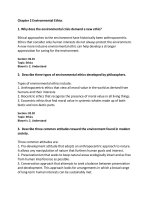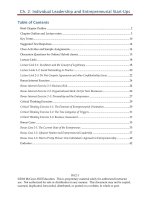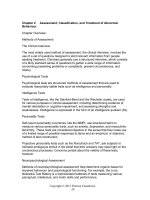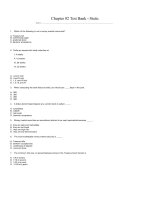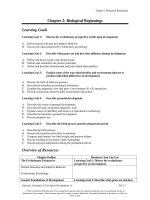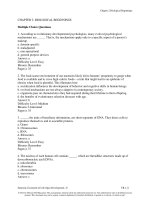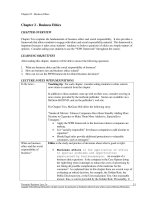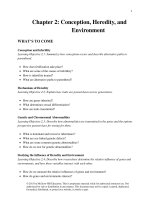Test bank and solution manual of CH02 asset classes and financial instrusment (2)
Bạn đang xem bản rút gọn của tài liệu. Xem và tải ngay bản đầy đủ của tài liệu tại đây (1.78 MB, 82 trang )
BKM_10e_Chap002.pdf
BKM_10e_IM_Ch02.pdf
BKM_Ess_10e_Ch02_Student.pdf
BKM_10e_Ch02.pdf
Chapter 02 - Asset Classes and Financial Instruments
CHAPTER 2
ASSET CLASSES AND FINANCIAL INSTRUMENTS
1. Common stock is an ownership share in a publicly held corporation. Common
shareholders have voting rights and may receive dividends. Preferred stock represents
nonvoting shares in a corporation, usually paying a fixed stream of dividends. While
corporate bonds are long-term debt issued by corporations, the bonds typically pay
semi-annual coupons and return the face value of the bond at maturity.
2. While the DJIA has 30 large corporations in the index, it does not represent the
overall market nearly as well as the more than 5000 stocks contained in The Wilshire
index. The DJIA is simply too small.
3. Money market securities are short-term, relatively low risk, and highly liquid. Also,
their unit value almost never changes.
4. The major components of the money market are Treasury bills, certificates of deposit,
commercial paper, bankers’ acceptances, Eurodollars, repos, reserves, federal funds,
and brokers’ calls.
5. American Depositary Receipts, or ADRs, are certificates traded in U.S. markets that
represent ownership in shares of a foreign company. Investors may also purchase
shares of foreign companies on foreign exchanges. Lastly, investors may use
international mutual funds to own shares indirectly.
6. The coupons paid by municipal bonds are exempt from federal income tax and from
state tax in many states. Therefore, the higher the tax bracket that the investor is in,
the more valuable the tax-exempt feature to the investor.
7. The London Interbank Offer Rate (LIBOR)—a key reference rate in the money
market—is the rate at which large banks in London are willing to lend money among
themselves. The Fed funds rate is the rate of interest on very short-term loans among
financial institutions in the U.S.
8. General obligation bonds are backed by the taxing power of the local governments,
while revenue bonds have proceeds attached to specific projects. A revenue bond has
fewer guarantees, it is riskier in terms of default, and, therefore, you expect it to have
a higher yield.
9. Corporations may exclude 70% of dividends received from domestic corporations in
the computation of their taxable income.
10. Limited liability means that the most shareholders can lose in event of the failure of
the corporation is their original investment.
Copyright © 2017 McGraw-Hill Education. All rights reserved. No reproduction or distribution without the prior written
consent of McGraw-Hill Education.
Chapter 02 - Asset Classes and Financial Instruments
11. (a) A repurchase agreement is the sale of a security with a commitment to repurchase
the same security at a specified future date and a designated price.
12. Money market securities are referred to as ―cash equivalents‖ because of their great
liquidity. The prices of money market securities are very stable, and they can be
converted to cash (i.e., sold) on very short notice and with very low transaction costs.
13. Equivalent taxable yield =
ate on municipal bond
- ax rate
=
rm
-t
=
-
= .1038 or
10.38%
14. After-tax yield = Rate on the taxable bond x (1 - Tax rate)
a. The taxable bond. With a zero tax bracket, the after-tax yield for the taxable
bond is the same as the before-tax yield (5%), which is greater than the 4%
yield on the municipal bond.
b. The taxable bond. The after-tax yield for the taxable bond is: 0.05 x (1 – 0.10)
= 0.045 or 4.50%.
c. Neither. The after-tax yield for the taxable bond is: 0.05 x (1 – 0.20) = 0.4 or
4%. The after-tax yield of taxable bond is the same as that of the municipal
bond.
d. The municipal bond. The after-tax yield for the taxable bond is: 0.05 x (1 –
0.30) = 0.035 or 3.5%. The municipal bond offers the higher after-tax yield
for investors in tax brackets above 20%.
15. The after-tax yield on the corporate bonds is: 0.09 x (1 – 0.30) = 0.063 or 6.3%.
Therefore, the municipals must offer at least 6.3% yields.
16. Using the formula of Equivalent taxable yield (r) =
a. r =
b. r =
c. r =
-
-
-
rm
-t
, we get:
= 0.04 or 4.00%
= 0.0444 or 4.44%
= 0.05 or 5.00%
Copyright © 2017 McGraw-Hill Education. All rights reserved. No reproduction or distribution without the prior written
consent of McGraw-Hill Education.
Chapter 02 - Asset Classes and Financial Instruments
d. r =
-
= 0.0571 or 5.71%
Copyright © 2017 McGraw-Hill Education. All rights reserved. No reproduction or distribution without the prior written
consent of McGraw-Hill Education.
Chapter 02 - Asset Classes and Financial Instruments
17.
a. You would have to pay the asked price of:
121.41 = 121.41% of par = $1,214.14
b. The coupon rate is 4.50%, implying coupon payments of $45.00 annually or,
more precisely, $22.50 (= 45.00/2) semiannually.
c. Given the asked price and coupon rate, we can calculate current yield with the
formula:
nnual coupon income
Current yield =
= 4.50/121.14 = 0.0371 = 3.71%
18.
a. The closing price today is $127.75, which is $0.90 above yesterday’s price.
Therefore, yesterday’s closing price was: $127.75 - $0.90 = $126.85.
b. You would buy 39 shares: $5,000/$127.75 = 39.14.
c. Your annual dividend income on 39 shares would be 39 x $2.48 = $96.72.
d. Earnings per share can be derived from the price-earnings (PE) ratio:
Given price/Earnings = 19.30 and Price = $127.75, we know that Earnings per
Share = $127.75/19.30 = $6.62.
19.
a. At t = 0, the value of the index is: ($90 + $50 + $100)/3 = 80
At t = 1, the value of the index is: ($95 + $45 + $110)/3 = 83.33
The rate of return is:
- 1 = (83.33/80) – 1 = 0.0417 or 4.17%
b. In the absence of a split, stock C would sell for $110, and the value of the
index would be the average price of the individual stocks included in the
index: ($95 + $45 + $110)/3 = $83.33.
After the split, stock C sells at $55; however, the value of the index should not
be affected by the split. We need to set the divisor (d) such that:
83.33 = ($95 + $45 + $55)/d
d = 2.34
c. The rate of return is zero. The value of the index remains unchanged since the
return on each stock separately equals zero.
Copyright © 2017 McGraw-Hill Education. All rights reserved. No reproduction or distribution without the prior written
consent of McGraw-Hill Education.
Chapter 02 - Asset Classes and Financial Instruments
20.
a. Total market value at t = 0 is:
($90 x 100) + ($50 x 200) + ($200 x 100) = $39,000
Total market value at t = 1 is:
($95 x 100) + ($45 x 200) + ($110 x 100) = $40,500
- 1 = ($40,500/$39,000) – 1 = 0.0385 or 3.85%
Rate of return =
b. The return on each stock is as follows:
RA =
- 1 = ($95/$90) – 1 = 0.0556 or 5.56%
RB =
- 1 = ($45/$50) – 1 = –0.10 or –10.00%
RC =
- 1 = ($110/$100) – 1 = 0.10 or 10.00%
The equally-weighted average is: [5.56% + (–10.00%) + 10.00%]/3 = 1.85%
21. The fund would require constant readjustment since every change in the price of a
stock would bring the fund asset allocation out of balance.
22. In this case, the value of the divisor will increase by an amount necessary to maintain
the index value on the day of the change. For example, if the index was comprised of
only one stock, it would increase by 2.06 points: ($180 – $34) / $34 = 4.29.
days
23. Bank discount of 87 days: 0.034 x
= 0.008217
a. Price: $10,000 x (1 – 0.008217) = $9,917.83
ace value - urchase price
b. Bond equivalent yield =
price
-
$ ,
=
$ ,
.
,
x
.
days
= 0.0348 or 3.48%
24.
a. The higher coupon bond: The 10-year T-bond with a 10% coupon
b. The call with the lower exercise price: The call with the exercise price of $35
c. The put option on the lower priced stock: The put on the stock selling at $50
Copyright © 2017 McGraw-Hill Education. All rights reserved. No reproduction or distribution without the prior written
consent of McGraw-Hill Education.
Chapter 02 - Asset Classes and Financial Instruments
25.
a. The December maturity futures price is $3.88 per bushel. If the contract
closes at $3.95 per bushel in December, your profit / loss on each contract (for
delivery of 5,000 bushels of corn) will be: ($3.95 – $3.88) x 5000 = $ 337.50
gain.
b. There are 99,741 contracts outstanding, representing 498,705,000 bushels of
corn.
26.
a. Yes. As long as the stock price at expiration exceeds the exercise price, it
makes sense to exercise the call.
Gross profit is: ($102 – $100) x 100 shares = $200
Net profit = ($2 – $2.62) x 100 shares = $62 loss
Rate of return = –$.62/$2.62 = –0.2366 or 23.66% loss
b. Yes, exercise.
Gross profit is: ($102 – $95) x 100 shares = $700
Net profit = ($7 – $6.35) x 100 shares = $65 gain
Rate of return = $65/$6.35 = 0.1024 or 10.24 % gain
c. A put with an exercise price of $100 would expire worthless for any stock
price equal to or greater than $100. An investment in such a put would have a
rate of return over the holding period of –100%.
27.
a.
b.
c.
d.
Long call
Long put
Short put
Short call
28. There is always a chance that the option will expire in the money. Investors will pay
something for this chance of a positive payoff.
29. Long call for $4:
a.
b.
c.
d.
e.
Value of call
at expiration
0
0
0
5
10
Initial Cost
Profit
4
4
4
4
4
-4
-4
-4
1
6
Copyright © 2017 McGraw-Hill Education. All rights reserved. No reproduction or distribution without the prior written
consent of McGraw-Hill Education.
Chapter 02 - Asset Classes and Financial Instruments
Long put for $6:
Value of put
at expiration
a.
10
b.
5
c.
0
d.
0
e.
0
Initial Cost
Profit
6
6
6
6
6
4
-1
-6
-6
-6
30. The spread will widen. Deterioration of the economy increases credit risk, that is, the
likelihood of default. Investors will demand a greater premium on debt securities
subject to default risk.
31. Six stocks have a 52-week high at least 40% above the 52-week low. It can be
concluded that individual stocks are much more volatile than a group of stocks.
52-wk
high
46.84
76.82
32.44
37.39
69.87
14.07
19.77
62.5
34.61
128.34
28.09
52-wk
low
36.13
56.57
14.02
25.5
45.27
12.12
15.01
39.01
20.21
83.61
23.5
Price ratio
(High-Low)/Low
0.30
0.36
1.31
0.47
0.54
0.16
0.32
0.60
0.71
0.53
0.20
32. The total before-tax income is $4. The corporations may exclude 70% of dividends
received from domestic corporations in the computation of their taxable income; the
taxable income is therefore: $4 x 30% = $1.20.
Income tax in the 30% tax bracket: $1.2 x 30% = $0.36
After-tax income = $4 – $0.36 = $3.64
After-tax rate of return = $3.64/$40 = 0.091 or 9.10%
33. A put option conveys the right to sell the underlying asset at the exercise price. A
short position in a futures contract carries an obligation to sell the underlying asset at
the futures price.
34. A call option conveys the right to buy the underlying asset at the exercise price. A
long position in a futures contract carries an obligation to buy the underlying asset at
the futures price.
Copyright © 2017 McGraw-Hill Education. All rights reserved. No reproduction or distribution without the prior written
consent of McGraw-Hill Education.
Chapter 02 - Asset Classes and Financial Instruments
CFA 1
Answer: c. Taxation
Copyright © 2017 McGraw-Hill Education. All rights reserved. No reproduction or distribution without the prior written
consent of McGraw-Hill Education.
Chapter 02 - Asset Classes and Financial Instruments
CHAPTER TWO
ASSET CLASSES AND FINANCIAL INSTRUMENTS
CHAPTER OVERVIEW
One of the early investment decisions that must be made in building a portfolio is asset
allocation. This chapter introduces some of the major features of different asset classes and
some of the instruments within each asset class. The chapter first covers money market
securities. Money markets are the markets for securities with an original issue maturity of one
year or less. These securities are typically marketable, liquid, low-risk debt securities. These
instruments are sometimes called “cash” instruments or “cash equivalents,” because they earn
little, and have little principal risk. After covering money markets, the chapter discusses the
major capital market instruments. The capital market discussion is divided into three parts, longterm debt, equity and derivatives. The construction and purpose of indexes is also covered in the
capital markets section.
LEARNING OBJECTIVES
Upon completion of this chapter the student should have an understanding of the various
financial instruments available to the potential investor. Readers should understand the
differences between discount yields and bond-equivalent yields and some money-market-ratequote conventions. The student should have an insight as to the interpretation, composition, and
calculation process involved in the various market indexes presented on the evening news.
Finally, the student should have a basic understanding of options and futures contracts.
CHAPTER OUTLINE
PPT 2-2
The major classes of financial assets or securities are presented in PPT slide 2. This material can
be used to discuss the chapter outline and the purposes of these markets. Instruments may be
classified by whether they represent money market instruments, which are primarily used for
savings, or capital market instruments. Savings may be defined as short-term investments that
pay a low rate of return but do not risk the principal invested. Capital market investments will
entail chance of loss of some or even all of the principal invested but promise higher rates of
return that allow significant growth in portfolio value.
Copyright © 2017 McGraw-Hill Education. All rights reserved. No reproduction or distribution without the prior written consent
of McGraw-Hill Education.
Chapter 02 - Asset Classes and Financial Instruments
1. Money Market Instruments
PPT 2-3 through PPT 2-11
The major money market instruments that are discussed in the text are presented in PPT 2-4
through PPT 2-11. Treasury bills, certificates of deposit (CDs) and commercial paper are
covered in the most detail. The issuer, typical or maximum maturity, denomination, liquidity,
default risk, interest type and tax status are presented for these instruments. The majority of
undergraduate students will have very little knowledge of the workings of these investments and
this is very useful information for them. Generally less detail is provided for bankers‟
acceptances, Eurodollars, federal funds, LIBOR, repos and the call money rate but the main
features of these instruments are covered. PPT slides 2-10 through 2-12 give data on money
market rates, the amounts of the different security types and spreads between CDs and T-bills.
Notice the big run up in spreads during the financial crisis. Make sure students understand the
meaning of credit spreads as this is a major predictor of market conditions. You may wish to
reference the following online article: “A Warning From the Bond Market”, Heard on the Street,
By Justin LaHart, Wall Street Journal Online, April 9, 2009.
Money Market Mutual Funds (MMMF) and the Credit Crisis of 2008:
PPT 2-12 shows that between 2005 and 2008 money market mutual funds (MMMFs) grew by
88%. Why? After years of declining growth rates, MMMF inflows accelerated rapidly as
investors fled risky assets during the crisis and sought safety in money funds. However, MMMFs
had their own crisis in 2008 after Lehman Brothers filed for bankruptcy on September 15
because some money funds had invested heavily in Lehman commercial paper. On Sept. 16 a
MMMF, the Reserve Primary Fund, “broke the buck.” What does this mean? MMMF shares
normally have a value of $1.00 plus any accrued interest, but fund shares are never supposed to
fall below $1.00. Some investors use these funds to pay bills as most have a checking feature
and count on the shares maintaining their value. Reserve Primary Fund shares fell below $1.00
as the fund‟s losses mounted. A run on money market funds ensued. The U.S. Treasury
temporarily offered to insure all money funds (for an insurance fee) to stop the run. Assets in
these funds total about $3.4 trillion.
Money Market Yields:
Copyright © 2017 McGraw-Hill Education. All rights reserved. No reproduction or distribution without the prior written consent
of McGraw-Hill Education.
Chapter 02 - Asset Classes and Financial Instruments
PPT 2-13 through PPT 2-19
Money market yield sample calculations are presented and illustrated in this set of slides. The
bank discount rate rBD is compared to the bond equivalent yield rBEY and the effective annual
yield rEAY.
rBD is calculated as a return as a percentage of the face value or par value of the instrument and is
quoted as annualized without compounding using a 360 day year. rBEY is calculated as a return as
a percentage of the initial price of the instrument and is quoted as annualized without
compounding using a 365-day year:
360
365
Price
Price
rBD ParPar
rBEY ParPrice
; n = maturity in days
n
n
The rEAY = holding period return as a percent of price but is annualized with compounding using
a 365 day year.
Price 365 n
rEAY (1 ParPrice
)
1
Examples are included with the slides. Note that the following relationship will normally hold:
rEAY > rBEY > rBD ceteris paribus.
Money Market Instruments and Yield Type
* Note that CDs, Euro$ and Federal Funds all use add-on quotes which are not quite the same as
BEY, since the add on uses a 360-day year. However, “add ons” are not covered in the text. To
convert from add on to BEY use the following: BEY = radd on * (365/360)
2. The Bond Market
Copyright © 2017 McGraw-Hill Education. All rights reserved. No reproduction or distribution without the prior written consent
of McGraw-Hill Education.
Chapter 02 - Asset Classes and Financial Instruments
PPT 2-20 through PPT 2-29
Debt instruments are issued by both government (sometimes called public) and by private
entities. The Treasury and Agency issues have the direct or implied guarantee of the federal
government. As state and local entities issue municipal bonds, performance on these bonds does
not have the same degree of safety as a federal government issue. The interest income on
municipal bonds is not subject to federal taxes so the taxable equivalent yield is used for
comparison.
Fixed-income securities have a defined stream of payments or coupons. Treasury notes have a
maturity up to and including 10 years; bonds mature beyond 10 years. The minimum
denomination is $100, but most have a $1,000 denomination, although many Treasuries are now
packaged and sold in multiples of $1,000. Treasury bonds pay interest semiannually with
principal repaid at maturity (non-amortizing). Most are callable after an initial call-protection
period. Investors pay federal taxes on capital gains and interest income, but interest income is
exempt from state and local taxes.
Agency issues have either explicit or implicit backing by the Federal Government and their
securities normally carry an interest rate only a few basis points over a comparable-maturity
Treasury instrument. Federal agencies have different charters but are generally charged with
assisting socially deserving sectors of the economy in obtaining credit. The major example is
housing, although farm lending and small business loans are other good examples. However, the
major agencies are home-mortgage related, and include the Federal National Mortgage
Association (FNMA or Fannie Mae); the Federal Home Loan Mortgage Corporation (FHLMC or
Freddie Mac); the Government National Mortgage Association (GNMA or Ginnie Mae); and the
Federal Home Loan Banks. GNMA has always been a government agency. GNMA backs pools
of FHA- and VA- insured mortgages (for a fee) created by private pool of organizers. FNMA
was originally a government agency that provided financing to originators of FHA and VA
mortgages, but was privatized in 1968. FHLMC was created in 1972 to assist in financing of
conventional mortgages. In September 2008, the federal government took over FNMA and
FHLMC and created a new regulator, the Federal Housing Financing Authority. FNMA and
FHLMC together finance or back about $6 trillion in home mortgages. This represents about
50% of the U.S. market.
Municipal bonds are issued by state and local governments. Interest on municipal bonds is not
taxed at the federal level and is usually not subject to state and local taxes if the investor
purchases a bond issued by an entity in their state of residence. To compare corporate yields
with municipal yields you must calculate the taxable equivalent yield. The conversion formula
rTax Exempt rTaxable (1 Tax Rate)
is:
Copyright © 2017 McGraw-Hill Education. All rights reserved. No reproduction or distribution without the prior written consent
of McGraw-Hill Education.
Chapter 02 - Asset Classes and Financial Instruments
Municipal bonds may be general obligation (G.O.) or revenue bonds. G.O. bonds are backed by
the full taxing power of the issuing municipality, whereas revenue bond payments are
collateralized only by the revenue of a specific project and tend to be riskier. Industrial
development bonds are municipal issues where the money is used for industrial development in
the local municipality. This may involve using the money to assist a specific business to
encourage that firm to locate a facility in the municipality.
Private Issues:
Private issues include corporate debt and equity issues and asset-backed securities, including
mortgage- backed securities. Bonds issued by private corporations are subject to greater default
risk than bonds issued by government entities. Corporate bonds often contain imbedded options
such as a call feature which allows an existing corporation to repurchase the bond from issuers
when rates have fallen. Some bonds are convertible which allows the bond investor to convert
the bond to a set number of shares of common stock. Most bonds are rated by one or more of the
major ratings agencies approved by the federal government. The major agencies are Standard &
Poors, Moody‟s and Fitch. The rating measures default risk. The higher the rating the lower the
interest rate required to issue the bonds. The two major classes of bonds with respect to default
risk are investment grade and speculative grade. Investment grade bonds are much more
marketable and carry significantly lower interest rates than speculative grade bonds. Speculative
grade bonds are euphemistically called „junk‟ bonds. Spreads on junk bonds reached record
highs in 2008 and 2009.
The mortgage market is now larger than the corporate bond market. Securities backed by
mortgages have also grown to compose a major element of the overall bond market. A passthrough security represents a proportional (pro-rata) share of a pool of mortgages. The mortgagebacked market has grown rapidly in recent years as shown in Text Figure 2.6. Originally only
“conforming mortgages” were securitized and used to back mortgage securities. Conforming
mortgages met traditional creditworthiness standards such as a maximum 80% loan-to-value
ratio; maximum debt-to-income ratio of around 30%; and a quality-credit score. Until about
2006, Fannie and Freddie only underwrote or guaranteed conforming mortgages. Under political
pressure to make housing available to low-income families however, Fannie and Freddie began
securitizing and backing subprime mortgages (mortgages to households with insufficient income
to qualify for a standard mortgage) and so called “Alt-A” mortgages which lie between
conforming and subprime in terms of credit risk. Most of the mortgages in the lower-quality
categories originated since 2006 have deteriorated in value. The term “underwater” means the
homeowners owe more than the market value of their home, creating an incentive to default.
Foreclosures depress local home prices, and add to the credit problems of banks and thrifts that
supply mortgage credit, hence the government‟s efforts to limit the number of foreclosures.
3. Equity Securities
Copyright © 2017 McGraw-Hill Education. All rights reserved. No reproduction or distribution without the prior written consent
of McGraw-Hill Education.
Chapter 02 - Asset Classes and Financial Instruments
PPT 2-30 through PPT 2-33
Several key points are relevant in the discussion of equity instruments. First, common stock
owners have a residual claim on the earnings (dividends) of the firm. Debt holders and preferred
stockholders have priority over common stockholders in the event of distress or bankruptcy.
Stockholders do have limited liability and a shareholder cannot lose more than their initial
investment. Common stockholders typically have the right to vote on the board of directors and
the board can hire and fire managers. Even though stockholders have the right to vote it may be
difficult to effect change because of a low concentration of stock holdings among many small
investors. For instance in the April 2009 shareholder meeting of Citicorp shareholders all
existing directors were reelected even though many shareholders were very vocal in their
disapproval of Citicorp‟s performance (Citicorp had abysmal performance in 2008 and had to be
bailed out by the government; most shareholder value was destroyed). Michael Jacobs, a former
Treasury official, wrote in The Wall Street Journal that Citicorp had few directors with
experience in the financial markets and GE had only one director with experience in a financial
institution even though GE Capital is a major component of the firm. Problems at GE Capital
led to a loss of GE‟s AAA credit rating.1
Preferred shareholders have a priority claim to income in the form of dividends. Ordinary
preferred stockholders are limited to the fixed dividend while common shareholders do not have
limits. The partial tax exemption on dividends of one corporation being received by another
corporation is important in discussing preferred stock. Preferred and common dividends are not
tax deductible to the issuing firm. Corporations are given a tax exemption on 70% of preferred
dividends earned.
Capital gains and dividend yields
You buy a share of stock for $50, hold it for one year, collect a $1.00 dividend and sell the stock
for $54. What were your dividend yield, capital gain yield and total return? (Ignore taxes)
o Dividend yield: = Dividend / Pbuy or $1.00 / $50 = 2%
o Capital gain yield: = (Psell – Pbuy)/ Pbuy or ($54 - $50) / $50 = 8%
o Total return: = Dividend yield + Capital gain yield
2%
+
8%
= 10%
4. Stock and Bond Market Indexes
1
“How Business Schools Have Failed Business: Why Not More Education on the Responsibility of Boards?” by Michael
Jacobs, The Wall Street Journal Online, April 24, 2009.
Copyright © 2017 McGraw-Hill Education. All rights reserved. No reproduction or distribution without the prior written consent
of McGraw-Hill Education.
Chapter 02 - Asset Classes and Financial Instruments
PPT 2-33 through PPT 2-40
Stock indexes are used to track average returns, compare investment managers‟ performance to
an index and as a base for derivative instruments. Key factors to consider in constructing an
index include a) what the index is supposed to measure, b) whether a representative sample of
firms can be used or whether all firms must be included, c) how the index should be constructed.
The examples of domestic indexes displayed in the PPT slides illustrate the diversity of indexes
in use. The Wilshire, being the broadest of the indexes, captures the overall domestic market.
The DJIA captures the returns from the „bluest of blue chips‟ or a sample of very large wellknown firms. The sample of domestic indexes also fit well with discussion of uses of the index.
If the index will be used to assess the performance of a manager that invests in Small-Cap firms,
the DJIA would not be as appropriate a benchmark as the NASDAQ Composite.
The creator of an index must decide how to weight the securities included in the index. Priceweighted indexes use the stock‟s price as the weight for that security. Price-weighted averages
are probably the poorest form of index because high price stocks have a bigger weight in the
index (there is no theoretical reason for this) and stock splits arbitrarily reduce that weight. The
other choices are market-value weighted (most common) and equal-value weighted. Which of
these two is better depends on your objectives. In a value-weighted index the amount invested in
each stock in the index is proportional to the market value of the firm. The market value of the
firm is the weight for each stock. Changes in the value of larger firms affect the index more than
changes in the value of the stock of a firm with smaller market capitalization. Value-weighted
indexes are more common and are probably a better indicator of the overall change in stocks‟
value. The theoretical market portfolio of all risky assets is value weighted. In constructing an
equal-weighted index, an equal amount of money is assumed to be invested in each stock.
Changes in the value of small firm and large firm stocks affect the index value identically.
While not as commonly used in many published indexes, the equal-weighted method is
commonly used in research. This method is important in describing results of empirical
examinations on market efficiency discussed in later chapters. Also if an investor actually does
put equal dollar amounts into various stocks then an equal-weighted index is probably the better
benchmark. The PPT slides contain sample calculations of price-weighted, value-weighted and
equal-weighted indexes for a simple three-stock index.
5. Derivative Securities
PPT 2-41 through PPT 2-49
Listed call options are explained and illustrated on slides 41 through 49. Calls and puts are
Copyright © 2017 McGraw-Hill Education. All rights reserved. No reproduction or distribution without the prior written consent
of McGraw-Hill Education.
Chapter 02 - Asset Classes and Financial Instruments
defined and Text Figure 2.10 is used to illustrate option quotes and very basic option positions.
The effect of exercise price and time to expiration on a call and a put are illustrated with this
figure. A very basic definition of a futures contract is provided on PPT slide 45. Figure 2.11 is
used to illustrate how to read a futures price quote for a corn futures contract.
The main point to emphasize in the option and futures discussion is that futures entail a
commitment to a future purchase or sale whereas options give the holder the right to buy (with a
call) or sell (with a put) the underlying commodity. The instructor should be aware that options
and futures markets are highly competitive. On the whole many futures markets are cheaper and
more liquid than options markets. The “right” associated with the option is more expensive.
Copyright © 2017 McGraw-Hill Education. All rights reserved. No reproduction or distribution without the prior written consent
of McGraw-Hill Education.
Suppose that short-term municipal bonds currently offer yields of 4
while comparable taxable bonds pay 5%. Which gives you the highe
after-tax yield?
ST municipal bond yield
Taxable bond yield
Solution
After-Tax Yield = Rate on the Taxable Bond x (1 - Tax Rate)
Tax bracket
a.
b.
c.
d.
After tax yield on
taxable bond
0.00%
0.00%
0.00%
0.00%
offer yields of 4%,
es you the higher
Higher yield
Turn to Figure 2.8 (listed below) and look at the listing for General D
a. What was the firm’s closing price yesterday?
b. How many shares could you buy for $5,000?
c. What would be your annual dividend income from those shares?
d. What must be General Dynamics’ earnings per share?
Close
Net Chg
Div
Yield
PE
Funds
Solution
a.
Yesterday's closing price =
$
-
b.
Shares purchased =
#DIV/0!
c.
Annual dividend =
#DIV/0!
d.
EPS =
#DIV/0!
rounded to the lowe
isting for General Dynamics.
om those shares?
share?
rounded to the lower share
